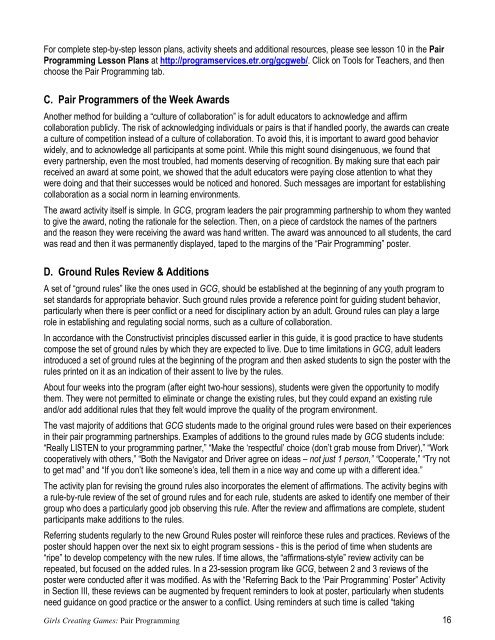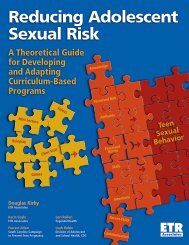Guide To Pair Programming - ETR Associates
Guide To Pair Programming - ETR Associates
Guide To Pair Programming - ETR Associates
Create successful ePaper yourself
Turn your PDF publications into a flip-book with our unique Google optimized e-Paper software.
For complete step-by-step lesson plans, activity sheets and additional resources, please see lesson 10 in the <strong>Pair</strong><strong>Programming</strong> Lesson Plans at http://programservices.etr.org/gcgweb/. Click on <strong>To</strong>ols for Teachers, and thenchoose the <strong>Pair</strong> <strong>Programming</strong> tab.C. <strong>Pair</strong> Programmers of the Week AwardsAnother method for building a “culture of collaboration” is for adult educators to acknowledge and affirmcollaboration publicly. The risk of acknowledging individuals or pairs is that if handled poorly, the awards can createa culture of competition instead of a culture of collaboration. <strong>To</strong> avoid this, it is important to award good behaviorwidely, and to acknowledge all participants at some point. While this might sound disingenuous, we found thatevery partnership, even the most troubled, had moments deserving of recognition. By making sure that each pairreceived an award at some point, we showed that the adult educators were paying close attention to what theywere doing and that their successes would be noticed and honored. Such messages are important for establishingcollaboration as a social norm in learning environments.The award activity itself is simple. In GCG, program leaders the pair programming partnership to whom they wantedto give the award, noting the rationale for the selection. Then, on a piece of cardstock the names of the partnersand the reason they were receiving the award was hand written. The award was announced to all students, the cardwas read and then it was permanently displayed, taped to the margins of the “<strong>Pair</strong> <strong>Programming</strong>” poster.D. Ground Rules Review & AdditionsA set of “ground rules” like the ones used in GCG, should be established at the beginning of any youth program toset standards for appropriate behavior. Such ground rules provide a reference point for guiding student behavior,particularly when there is peer conflict or a need for disciplinary action by an adult. Ground rules can play a largerole in establishing and regulating social norms, such as a culture of collaboration.In accordance with the Constructivist principles discussed earlier in this guide, it is good practice to have studentscompose the set of ground rules by which they are expected to live. Due to time limitations in GCG, adult leadersintroduced a set of ground rules at the beginning of the program and then asked students to sign the poster with therules printed on it as an indication of their assent to live by the rules.About four weeks into the program (after eight two-hour sessions), students were given the opportunity to modifythem. They were not permitted to eliminate or change the existing rules, but they could expand an existing ruleand/or add additional rules that they felt would improve the quality of the program environment.The vast majority of additions that GCG students made to the original ground rules were based on their experiencesin their pair programming partnerships. Examples of additions to the ground rules made by GCG students include:“Really LISTEN to your programming partner,” “Make the ‘respectful’ choice (don’t grab mouse from Driver),” “Workcooperatively with others,” “Both the Navigator and Driver agree on ideas – not just 1 person,” “Cooperate,” “Try notto get mad” and “If you don’t like someone’s idea, tell them in a nice way and come up with a different idea.”The activity plan for revising the ground rules also incorporates the element of affirmations. The activity begins witha rule-by-rule review of the set of ground rules and for each rule, students are asked to identify one member of theirgroup who does a particularly good job observing this rule. After the review and affirmations are complete, studentparticipants make additions to the rules.Referring students regularly to the new Ground Rules poster will reinforce these rules and practices. Reviews of theposter should happen over the next six to eight program sessions - this is the period of time when students are“ripe” to develop competency with the new rules. If time allows, the “affirmations-style” review activity can berepeated, but focused on the added rules. In a 23-session program like GCG, between 2 and 3 reviews of theposter were conducted after it was modified. As with the “Referring Back to the ‘<strong>Pair</strong> <strong>Programming</strong>’ Poster” Activityin Section III, these reviews can be augmented by frequent reminders to look at poster, particularly when studentsneed guidance on good practice or the answer to a conflict. Using reminders at such time is called “takingGirls Creating Games: <strong>Pair</strong> <strong>Programming</strong> 16
















